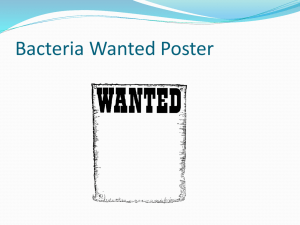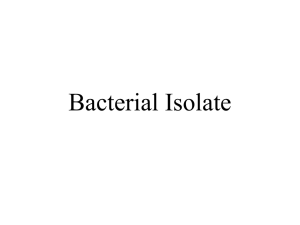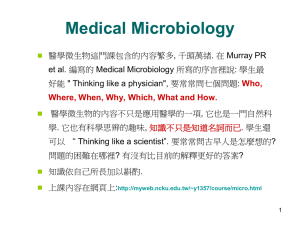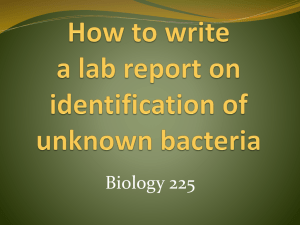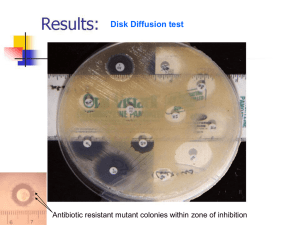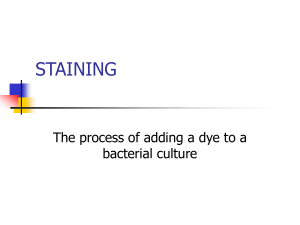Culture - Microbiology and Immunology Online
advertisement
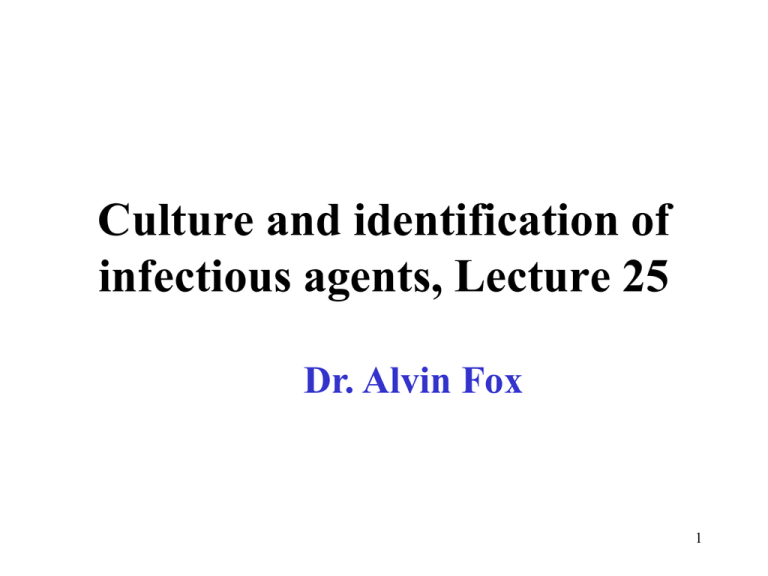
Culture and identification of infectious agents, Lecture 25 Dr. Alvin Fox 1 Key Terms Isolation (culture) • Agar plate plate/colonies • Liquid media Identification & taxonomy • Family • Genus • Species • Type • Strain After culture • Biochemical (physiological) tests • Genetic tests - Polymerase chain reaction (PCR) - Sequencing - DNA-DNA homology/arrays - Restriction enzymes (digests) • Chemical - fatty acid/protein profiling • Immunological Direct detection (i.e. without culture) • PCR • Antigen detection • Staining (e.g. Gram stain) 2 • Serology (antibody detection) Taxonomy • Defines common traits among strains for a bacterial species • Usually genetic • Allows development of diagnostic kits 3 Species versus strains - selecting discriminating features 4 Classification • • • • • Strain: one single isolate or line Type: sub-set of species Species: related strains Genus: related species Family: related genera 5 Both terms define the species name Streptococcus pyogenes Genus part Species part So Streptococcus pyogenes and Streptococus agalactiae would be two species in the same genus In a report On first usage: Streptococcus pyogenes On second usage: S. pyogenes 6 Identification of infectious agents in the diagnostic laboratory • Aids treatment • Helps antibiotic selection • General hospital laboratory – physiological tests • More fully equipped laboratories – Genetic tests 7 Steps in isolation and identification • Step 1: Streaking culture plates – colonies on incubation (e.g 24 hr) – size, texture, color, hemolysis – oxygen requirement 8 Sheep blood agar plate culture Bacillus cereus. Bacillus anthracis CDC/Dr. James Feeley 9 Mixed colonies 10 Isolation and identification • Step 2: Colonies Gram stained – cells observed microscopically 11 Gram negative Gram positive Heat/Dry Crystal violet stain Iodine Fix Alcohol de-stain Safranin stain 12 Gram stain morphology • Shape – cocci (round) – bacilli (rods) – spiral or curved (e.g. spirochetes) • Single or multiple cells – clusters (e.g. staphylococci) – chains (e.g. streptococci) • Gram positive or negative 13 Step 3: Isolated bacteria are speciated • Generally using physiological tests 14 Clinical Microbiology Laboratory Bench 15 Step 4: Antibiotic susceptibility testing 16 Antibiotic susceptibility testing Susceptible Not susceptible Bacterial lawn No growth Growth Antibiotic disk 17 Molecular differentiation • Genomics • Gene characterization – PCR – Sequencing – Restriction digestion • Hybridization (probes, arrays) • % guanine-cytosine 18 16S rRNA Sequencing • Differentiates bacterial species • Development of clinical tests based on sequence (e.g. PCR) 19 Real-time PCR ds DNA Cycle one Dye Cycle two Cycle 30 2 30 20 DNA-DNA hybridization Strain 1 Heat + 0% Homology Strain 2 100% Homology 21 Profiles • Long chain fatty acids - structural (e.g. cell membrane) • Short chain - metabolic - volatiles - Fatty acids/alcohols 22 • Protein profiling: defining a species by characteristic (low molecular weight) proteins • Proteomics: defining all proteins expressed by a species under specific growth conditions 23 Bacterial DNA sequences can be amplified directly from human body fluids 24 Laboratory diagnosis without culture In general, when speed is of essence Of additional importance: • The organism grows poorly/slowly • The organism can’t be cultured 25 Microscopy • spinal fluids (meningitis) • sputum (tuberculosis) • sensitivity poor 26 Streptococcal Agglutination Test Streptococcal antigenic extract Antibody Latex beads 27 Serologic identification • antibody response to the infecting agent • several weeks after an infection has occurred 28 Epidemics • associated with particular strains/types • state or federal laboratory system 29

